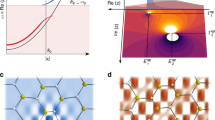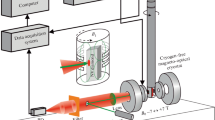Abstract
The effect of micro-doping, defect creation, and non-steady state occupation through optical transitions on the electron spin resonance signals found in undoped and weakly doped microcrystalline silicon with a high degree of crystallinity is investigated. The experimental results are in agreement with the assignment of the resonance at g=1.9983 to conduction electrons in the crystalline grains and the resonanccs around g=2.0052 to dangling bonds in the remaining amorphous phase and at the grain boundaries. The simultaneous presence of both resonances can result from a large conduction band offset between crystalline grains and grain boundaries or the amorphous phase. The presence of conduction electron spin resonance in compensated and even p-type material points also to potential fluctuations. Free electrons in interconnected crystalline grains are in agreement with the weakly activated transport found in μc-Si:H at low temperatures.
Similar content being viewed by others
References
F. Finger, C. Malten, P. Hapke, R. Carius, R. Flückiger and H. Wagner, Phil. Mag. Lett. 70 (1994) 247
F. Finger, P. Hapke, M. Luysberg, R. Carius, H. Wagner and M. Scheib, Appl. Physics Lett. 65 (1994) 2588
P. Hapke, F. Finger, M. Luysberg, R. Carius and H. Wagner, this conference
R. Fluckiger, J. Meier, H. Keppner, M. Goetz and A. Shah, Proc. 23rd IEEE Photovoltaic Specialist Conference, Louisville, Kentucky (1993) 839
G. Willeke, in Physics and applications of amorphous and microcrystalline semiconductor devices, edited by J. Kanicki, Artech House (1992) 55
P. S. Caplan, E. H. Pointdexter, B. E. Deal and R. R. Razouk, J. Appl. Phys. 50 (1979) 5847
E. G. Sieverts, Phys. Stat. Sol. B 120 (1983) 11
M. Suezawa, K. Sumino and M. Iwaizumi, J. Appl. Phys. 54 (1983) 6594
D. Ballutaud, M. Aucouturier and F. Babonneau, Appl. Phys. Lett. 49 (1986) 1620
A. M. Portis, A. F. Kip, C. Kittel, and W. H. Brattain, Phys. Rev. 90 (1953) 988
S. Hasegawa, T. Kasajima, and T. Shimizu, J. Appl. Phys. 50 (1979) 7256
S. Hasegawa, S. Narikawa, and Y. Kurata, Phil. Mag. B 48 (1983) 431
von H. J. Bardleben, C. Ortega, A. Grosman, V. Morazzani, J. Siejka and D. Stievenard, J. Luminescence 57 (1993) 301
M. Tzolov and P. Hapke, unpublished
H. Overhof and P. Thomas, Electronic Transport in Hydrogenated Amorphous Semiconductors, Springer Tracts In Modern Physics Vol. 114, Berlin (1989)
Author information
Authors and Affiliations
Rights and permissions
About this article
Cite this article
Malten, C., Finger, F., Hapke, P. et al. Spin Resonance Studies on free Electrons and Defects in Microcrystalline Silicon. MRS Online Proceedings Library 358, 757 (1994). https://doi.org/10.1557/PROC-358-757
Published:
DOI: https://doi.org/10.1557/PROC-358-757




